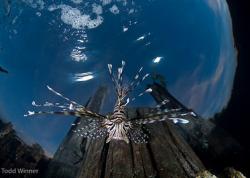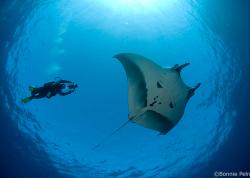Channel Islands Diving & Underwater Photography
The northern and southern Channel Islands are rich in California marine life, and offer giant kelp forests, black sea bass, bat rays, great macro life, and year-round scuba diving. They lie 15-50 miles off the coast of southern California. The best diving can be found at any of these islands, and within the Marine Protected Areas.


Bat ray in kelp, Anacapa Island
Diving the Northern Channel Islands
Anacapa Island dive sites & underwater photography
Anacapa is a short boat trip from Ventura and Oxnard, and day trips run often. This is one of my favorite islands for diving. Visibility is usually 30-50ft, the island is quite protected, and the reefs have more marine life than Catalina, although the water temps are a little cooler. Best diving is usually on the east & west ends, and on the south side. Dives sites are usually a little more shallow at Anacapa, and I usually don't need Nitrox, unless I am focusing on macro. Diving Anacapa island is always a treat.

Shallow eelgrass at Channels, Anacapa Island
Anacapa Island's best dive sites
Cathedral cove - Giant Kelp forest and a sea lion rookery make this Anacapa dive site excellent for wide-angle photography.
Landings cove - I always find great macro opportunities, including nudibranchs here, between 30-60ft depth. There is a large underwater arch here that you can easily swim though, with excellent fish and macro subjects on both sides of the arch.
Coral reef - sometimes currents can be strong here, but excellent macro and good wide-angle photography are good here, and there are usually millions of brittle stars forming a brittle star carpet from 60-80ft depth.
Channels - beautiful shallow area that is excellent for wide-angle photography, usually with Harbor Seals. It's very near a good macro site called Underwater Island, which is simply in deeper water
Rat Rock - the very west end of Anacapa has very good overall diving when conditions allow diving here. Great for wide-angle or macro.
Portuguese Rock - there are some interesting critters in the sand that will interest the underwater macro photographer. It's on the edge of the Pelican reserve. 15-40ft depth.
Pelican reserve -great for macro, juvenile fish and uncommon critters. However, this area can only be dove in November, it's closed the rest of the year.
Cat Rock - a solid site on the south side, with healthy kelp, good structure and brittle stars deeper.

Sea lions in the kelp, Cathedral cove, Anacapa Island

Brittle star carpet at Anacapa island. The south side of Anacapa gets carpeted with colorful brittle stars at 50-70ft depth, and even some parts of the north side.
Santa Cruz Island dive sites & underwater photography
The further west you go on Santa Cruz, the better the diving gets. There are prolific macro and wide-angle opportunities here, although visibility here is variable due to runoff and the nutrient rich waters.

Island kelpfish, santa cruz island
Santa Cruz island dive sites
Gull Island - This marine reserve has lush kelp, large fish, sea lions and harbor seals, and large patches of purple hydrocoral in shallow water. Southwest side of Santa Cruz.
West end Pinnacles - Great structure, pinnacles, sand channels, excellent macro life. Often not diveable due to exposed nature. This is the extreme west end of Santa Cruz.
Painted Cave area - Sea lions, rich marine life, many walls nearby. On the north side of the western half of the island.
Bowen Point - Lush kelp forests, good structure, torpedo rays. On the south side.
Potato Rock - Potato rock is a small pinnacle with good macro life and nudibranchs.
Flame Reef - located near the east end on the south side, flame reef is a great macro site filled with nudibranchs, small fish and other critters. If the current is not strong, do multiple dives here if possible.
More information can be found in our Santa Cruz Channel Islands Dive Report.

Purple hydrocoral, giant kelp and sea lion at Gull Island, Santa Cruz Island. F8, 1/126th, ISO 400, Tokina 10-17mm lens at 10mm

Harbor seal, west end of Santa Cruz Island
Santa Rosa Island dive sites & underwater photography
Santa Rosa Island, better known for lobster hunting, is usually not an underwater photography destination, due to better sites at Santa Cruz or San Miguel, surge and lower visibility. The marine life here is similar to San Miguel.
Bee Rock, offshore on the southwest side, is one of the better dive sites.
East end pinnacles - there are several underwater pinnacles on the south-east side that offer better diving than most places around the island. The tops of the pinnacles are at around 50ft.
San Miguel Island dive sites & underwater photography
San Miguel is very exposed, making conditions for underwater photography very difficult. However, the macro photography here can be excellent and very colorful, if a little bit surgy.

Mosshead Warbonnet, Wyckoff ledge, San Miguel Island. Many "northern" species can be found at San Miguel.
San Miguel Island's best dive sites
Wyckoff ledge - my favorite spot for underwater photography at San Miguel, this area is somewhat protected and offers good macro photography opportunities shallow and deep, from 30ft - 100ft. See Wolf eels, rare Mosshead warbonnets, and many nudibranchs.
Rainbarrel - large kelp forest on the south side, and full of Abalones.
Judith rock pinnacle - beautiful pinnacle off southwest San Miguel, but sometimes with heavy currents. 55-60ft at the top.
Richardson Rock -beautiful pinnacle offshore northwest San Miguel, but rarely diveable and with heavy surge. Excellent down deep
Wilson Rock - beautiful pinnacle offshore northwest San Miguel, but rarely diveable and with heavy surge. Excellent down deep
Skyscraper & Boomerang - beautiful deep seamounts offshore northwest San Miguel, but rarely diveable and with heavy surge. Excellent down deep. 55-60ft at the top.

Colorful nudibranchs like this Dendronotus albus cover the reefs at San Miguel Island.
Diving the Southern Channel Islands
Catalina Island dive sites & underwater photography
Please see the page on Catalina island diving & photography

Giant kelp forest at Catalina Island
San Clemente Island dive sites & underwater photography
With the best kelp, clearest warmest water, and great structure, San Clemente is an excellent destination for wide-angle underwater photography. Unfortunately the Navy often closes a large portion of the island, so it is not always diveable. The southeast corner is dove the most, due to the rest being frequently closed for Navy practice.

Kelp forest at San Clemente island. Read more about navigating kelp safely.
San Clemente island dive sites
Pyramid Cove - large dive site with beautiful kelp, sea fans and structure
Castle Rock - nice kelp forest and shallow caves
Nine Fathoms - also known as Arch rock. A deep offshore reef with purple hydrocoral on the northwest end. 60 feet depth at the top.
Little Flower - beautiful large reef in a protected cove, great for wide-angle underwater photography. Sometimes you'll find soupfin sharks here.
Santa Barbara Island dive sites & underwater photography
Santa barbara is a popular overnight trip because of its sea lion rookery. Many playful sea lions will come and visit you in a sandy dive site on the southeast corner of Santa Barbara island. This is considered the best place in Southern California to photograph sea lions. The island is very exposed, and the other excellent dive sites are often not diveable.
Santa Barbara Island dive sites
Sea Lion Rookery - shallow diving, sheltered, lots of sea lions in clear water
Archway - rich in marine life, purple hydrocoral
Black Cavern - a deep site with many caves and caverns
Sutil - a large offshore rock, with beautiful kelp forests
Brittle Star Reef - millions of brittle stars carpet the floor at 60-75ft depth, with a nice rocky reef and kelp

At Santa Barbara Island, you might have 20 sea lions coming at you!
San Nicolas Island dive sites & underwater photography
San Nicolas Island is very exposed, and dive boats rarely go out here. Much of the island is closed off to diving by the Navy. The best diving is at Begg Rock, a pinnacle 8 miles off the coast of San Nicolas island. Begg Rock is packed with marine life and goes very deep, but due to its exposed nature is for very advanced divers only.
When to dive the channel islands
The best underwater visibility in the Channel Islands is from July to January, with visibility peaking from September to November. The southern Channel Islands have the clearest water, with up to 80ft of visibility. Sometimes January and February can have good vis also.
Black sea bass and large baitballs visit in the summer and fall.
The warmest temperatures are from mid-July to late October, over 70 degrees Fahrenheit at the surface, and the coldest waters are from February to late June, in the low 50's. Catalina and San Clemente have the warmest water, and San Miguel has very cold water that can be in the 40's.
The dive boats can be crowded in July and August.
Jan to March can be clear and cold, with rain sometimes. April - June can have plankton blooms and green water, and visibility can drop to 20ft, especially in the northern Channel Islands.
The northern Channel Islands are usually dived out of Ventura and Santa Barbara, while the southern Channel Islands are dove from San Pedro or Long Beach.
How to dive the Channel Islands
With the exception of Catalina Island, the only way to dive the Channel Islands is via a boat. Most divers choose 1 or 2 day trips, doing 3-4 dives on a 1 day trip or 7-8 dives on a 2 day trip.
Boats out of Ventura and Santa Barbara will take you to Anacapa, Santa Cruz, Santa Rosa, and San Miguel island.
Boats out of San Pedro and Long Beach visit Catalina, San Clemente and Santa Barbara islands, although the boats out of Santa Barbara / Ventura will sometimes visit these spots on a 2 or 3 day trip.
You will be responsible for your dive equipment, and also your tank and weights unless you make special arrangements.

Giant black sea bass at Anacapa island
Best underwater photography subjects in the channel islands
Giant kelp forests, baitballs, schooling fish, bat rays, angel sharks, torpedo rays, giant black sea bass, sea lions, harbor seals, sea fans, horn sharks
Macro subjects: Colorful anemones, corynactis-encrusted reefs, nudibranchs, juvenile fish, octopus, moray eels, shrimp, kelp closeups

Dendronotus albus nudibranch, Santa Cruz Island
Further Reading
Best Underwater photography destinations
Catalina island underwater photography
Guide to California Marine Life
Resource for Marine Life Identification: ReefID

RECOMMENDED ARTICLES
SUPPORT THE UNDERWATER PHOTOGRAPHY GUIDE:
The Best Service & Prices on u/w Photo Gear
 Visit Bluewater Photo & Video for all your underwater photography and video gear. Click, or call the team at (310) 633-5052 for expert advice!
Visit Bluewater Photo & Video for all your underwater photography and video gear. Click, or call the team at (310) 633-5052 for expert advice!
The Best Pricing, Service & Expert Advice to Book your Dive Trips
 Bluewater Travel is your full-service scuba travel agency. Let our expert advisers plan and book your next dive vacation. Run by divers, for divers.
Bluewater Travel is your full-service scuba travel agency. Let our expert advisers plan and book your next dive vacation. Run by divers, for divers.

































